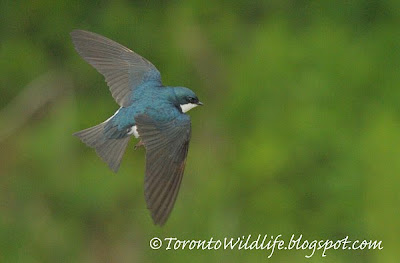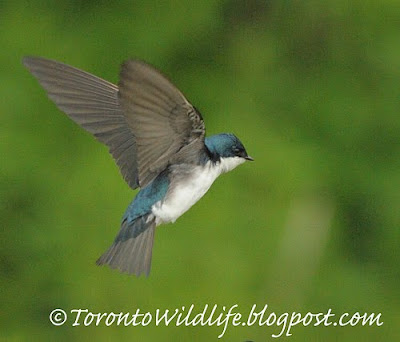
So how the heck do you shoot something like this? It's not quite as hard as you might think.
You do need a DSLR. It would help if you have a lens that focuses pretty quickly but many consumer-level lenses should be good enough. You also need a flash. If you can find a pond or body of water in or near a park you're halfway to finding tree swallows. Normally for shooting birds in flight you'd want a nice sunny day because otherwise you'll get backlighting from the clouds and end up shooting a bunch of dark silhouettes. The day I shot this it was actually cloudy but it was okay because I had a vantage point where I could shoot down at the birdies as they circled around a pond. The clouds ended up providing a nice even look without too much contrast. Sun or clouds you should use your flash because it will help to emphasize the swallows' iridescent feathers and give a nice sparkle to their eyes. Set your flash for TTL BL (consult the manual). Then set the shutter speed of your camera to at least 1/800th of a second.
Okay, now comes the tricky part.
Start trying to shoot the tree swallows as they dart around in circles. Repeat until insane. You can shoot swallows this way but it's very time-consuming and takes a lot of practice. Luckily there's a much easier method that follows solidly in an important time-honoured tradition of nature photography.
You can cheat!
Where was that swallow heading when I shot that first image? He was heading here.

That's him on the left. In the first shot he was coming in for a landing. The same is true in these.


So if you can find a tree branch or bird house that the swallows have made their own, all you need to do is get them as they're coming and going from that spot. This provides a reference point for your focus and makes things a lot easier than just trying to nail a shot in free space. Let me also emphasize that since you're just cropping judiciously this method isn't really cheating. You're not cloning anything out of the image -- a no-no in nature photography.
Go out and try this yourself. But do remember this method only makes things easier. If it was really easy it wouldn't be any fun.
